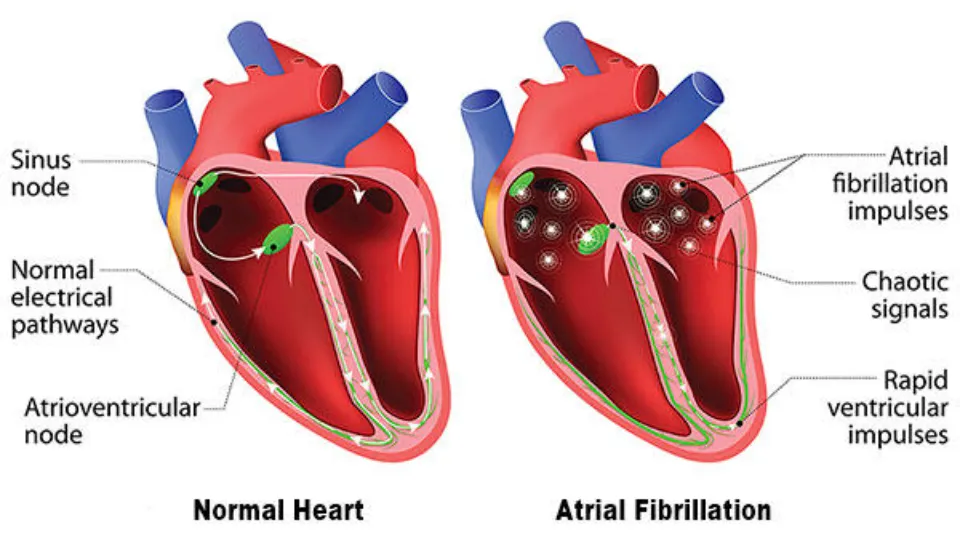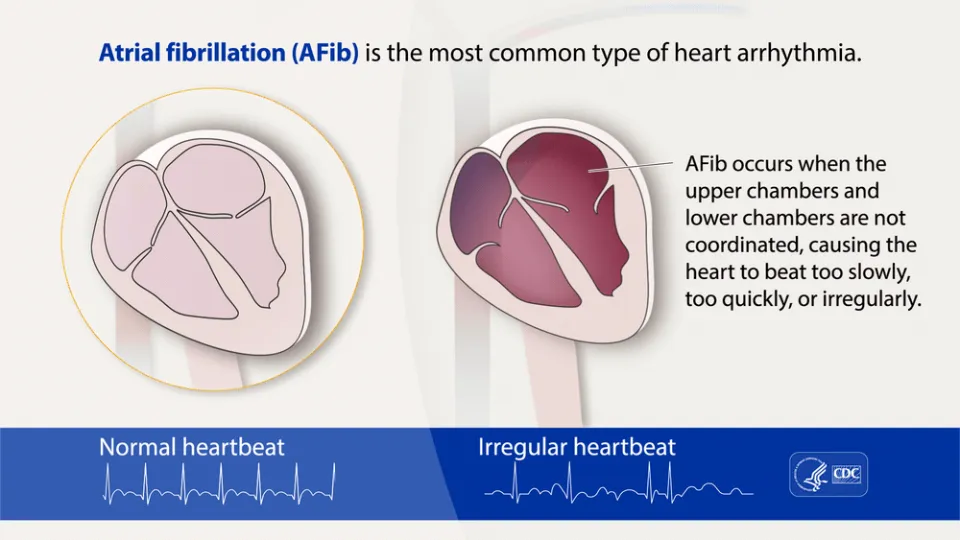Atrial fibrillation (AFib) is the most common type of arrhythmia in older adults. Your likelihood of getting AFib rises as you age.
Atrial fibrillation (AF) is the most common heart rhythm abnormality and has a significant disease burden. Stroke is one of its deadly side effects, and as people age, their risk increases. Therefore, older adults with AF have a high risk of stroke.
Better treatment options for AFib in older adults are still being developed by experts. y For more information on AFib, continue reading.
What is AFib?
Atrial fibrillation is a heart condition that causes an irregular and often abnormally fast heart rate.
A normal heart rate should be regular and between 60 and 100 beats a minute when you’re resting.
By feeling your pulse in your wrist or neck, you can determine your heart rate.
The heart rate is erratic and occasionally extremely rapid in atrial fibrillation. It can occasionally be much higher than 100 beats per minute.
This may result in issues like fatigue, shortness of breath, and dizziness.

Heart palpitations are heartbeats that are noticeable and last for a few seconds or, in some cases, a few minutes. They can feel like your heart is pounding, fluttering, or beating irregularly.
Sometimes atrial fibrillation does not manifest any symptoms, and the person experiencing it is completely unaware that their heart rate is abnormal.
How Dangerous is AFib in Elderly?
You can get AFib at any age. But simply being older raises your chances for AFib. However, older people are more likely to have additional medical conditions that increase your risk of AFib. These include:
- High blood pressure
- Coronary artery disease
- Heart valve problems
- Heart failure
AFib and age each raise your risk of a stroke. This indicates that your risk of stroke is significantly increased if you are an older adult with AFib. One study discovered that 5 years after developing AFib, nearly 8 out of 100 women aged 70 experienced a stroke. In comparison, 3 out of 100 women of the same age who did not have AFib had this condition. According to the same study, 7 in 100 men aged 70 or older with AFib experienced a stroke within 5 years. One stroke occurred in every five men of the same age who did not have AFib.
You can control some things that could make you more susceptible to AFib as you get older. These include:
Body massindex (BMI). Obesity plays a large role in the development of AFib. You’ll be more likely to develop AFib if your BMI is higher. AFib sufferers are more likely to gain weight, which increases the likelihood that their condition will worsen. Maintaining a healthy BMI is important, especially as you age.
Sleep apnea with obstruction (OSA). You’re more likely to develop OSA as you age. Experts have found that OSA is a risk factor for stroke and may put you at a higher risk for AFib.

Diabetes. Although type 2 diabetes can occur at any age, it tends to strike middle-aged and older adults more frequently. Your risk of developing AFib is significantly higher if you have type 2 diabetes than it is for those who do not. Because of this, it’s important that you lower your risk for type two diabetes.
You can lower your risk of type two diabetes if you:
- Lose extra weight
- Get more exercise
- Eat healthy fats and focus on a plant-based diet
- Stay away from fad diets and focus on balanced nutrition
How to Treat AFib in Older Adults?
There are a few ways to treat AFib. The primary objective of AFib treatment is to avoid problems like strokes that are caused by blood clots. This will be accomplished by your doctor using anticoagulant therapy, or blood clot-preventing treatments. You’re more likely to live longer if your doctor can reduce this risk.
They’ll then want to treat you in order to improve your quality of life. In order to reduce your symptoms and hospital visits, your doctor will try. You’ll employ rhythm or rate control therapies to achieve this.
Some treatments for AFib include:
treatment with anticoagulants. Age-related AFib patients are advised to take blood clot-prevention medications, according to experts. However, it’s crucial that your doctor keep an eye on you as you receive these treatments. Sometimes they can make bleeding more likely.
Antiarrhythmic drugs. Your heart rate will be regulated by these types of treatment. Antiarrhythmic medications are particularly beneficial for older adults with AFib who have no symptoms.
Treatments for rhythm control might be beneficial. However, in elderly AFib patients, they may also cause serious side effects.
Catheter ablation. If you have AFib, this treatment may be able to maintain a regular heartbeat for you. But it might be dangerous if you’re older. The good news is that researchers are still developing ablation techniques that may benefit older people who have AFib.
Left atrial appendage closure through surgery. This procedure can be used in place of anticoagulation therapy if you cannot tolerate it or do not desire it. Your left atrial appendage will be cut off during surgery, which will also lower your risk of stroke and other AFib-related risks.
Final Thoughts
Atrial fibrillation risk factors for seniors include high blood pressure, coronary artery disease, issues with the heart’s valves, and heart failure. Seniors are also more likely to develop these conditions as they get older. But keep in mind that there are lifestyle decisions older adults can make to enhance their overall heart health and possibly fend off atrial fibrillation and other forms of heart disease.
FAQs
How Common is AFib in the Elderly?
Its prevalence in the general population increases steadily with advancing age, from 0.12–0.16% in people younger than 49 years to 3.7–4.2% in those aged 60–70 years. Prevalence can reach 10–17% after the age of 80.
How Long Can An Elderly Person Live With AFib?
What Is the Prognosis for Older Adults With AFib? Men between the ages 55-74 with AFib have a 61.5% death rate within 10 years of diagnosis. In contrast, the rate for men without the condition is 30%. Women of the same age with AFib had a 10-year mortality rate of 57.6% compared to 20.9% for women without AFib.



